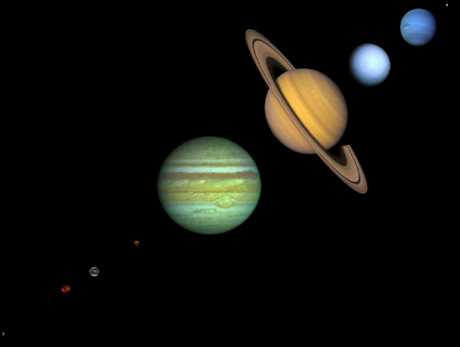Space EnvironmentWhat is in space? |
Earth and the other three inner planets of our solar system (Mercury, Venus and Mars) are made of rock, containing common minerals like feldspars and metals like magnesium and aluminum. So is Pluto. The other planets are not solid. Jupiter, for instance, is made up mostly of trapped helium, hydrogen, and water. In our solar system, the four "gas giants" are Jupiter, Saturn, Neptune, and Uranus.

Planets with their relative sizes to scale. The tiny bluish dot at the lower
left is Earth. The tiny red dots to either side are Venus and Mars. Mercury
and Pluto are pinpoints at opposite corners.Image from The Nine Planets,
a Multimedia tour of the Solar System by Bill Arnett http://seds.lpl.arizona.edu/nineplanets/nineplanets/nineplanets.html
Scientists define planets as dark bodies that orbit around stars. Dark bodies are objects in space that do not release enough light to be visible to the eye. We can still see the planets (and our moon) in the night sky because light from the Sun reflects off of them.

Colors of the planets. This picture is not to scale. Image from NASA's Planetary
Photogrounal at http://photojournal.jpl.nasa.gov/
![]()
What is in space besides planets and stars?
What is an orbit?
What causes an orbit to happen?
What travels in an orbit?
What is a satellite?
![]()
![]()
How do we know what's in space?
What are the orbital lengths and distances of objects in our solar system?
![]()